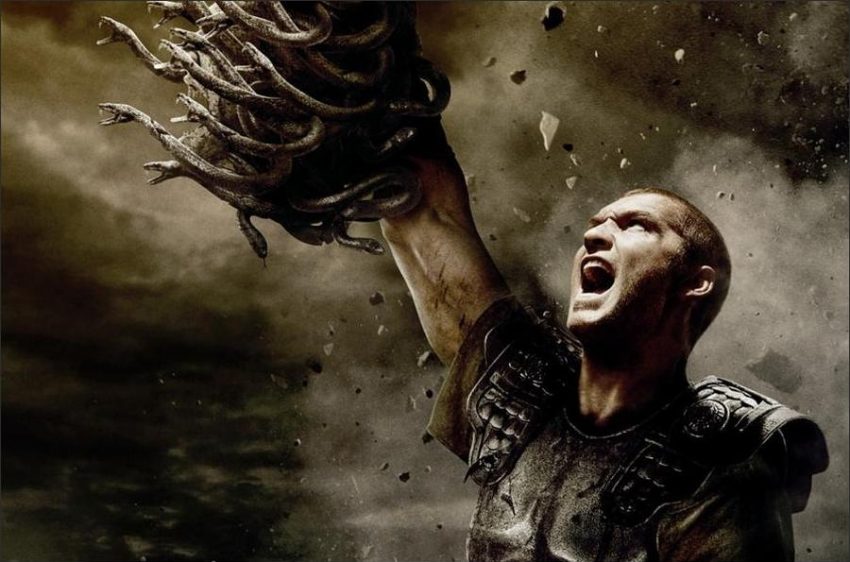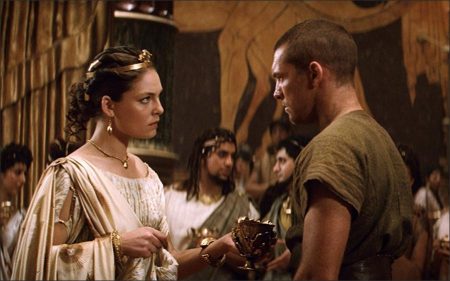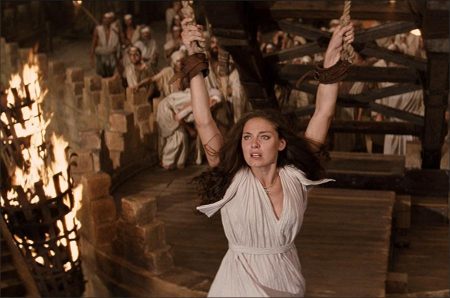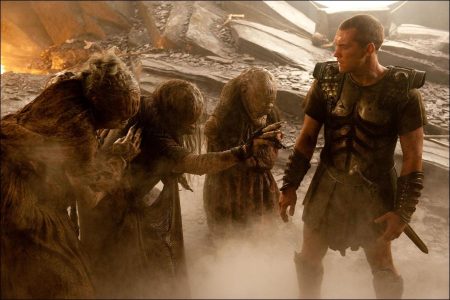Taglines: Between gods and men, the clash begins.
Born of a good but raised as a man, Perseus is helpless to save his family from Hades. He volunteers to lead a dangerous mission to defeat Hades before he can unleash hell on earth. The ultimate struggle for power pits men against kings and kings against gods. But the war between the gods themselves could destroy the world. Born of a god but raised as a man, Perseus (Sam Worthington) is helpless to save his family from Hades (Ralph Fiennes), vengeful god of the underworld.
With nothing left to lose, Perseus volunteers to lead a dangerous mission to defeat Hades before he can seize power from Zeus (Liam Neeson) and unleash hell on earth. Leading a daring band of warriors, Perseus sets off on a perilous journey deep into forbidden worlds. Battling unholy demons and fearsome beasts, he will only survive if he can accept his power as a god, defy his fate and create his own destiny.
With larger-than-life mythical beasts, breathtaking vistas spanning the depths of hell to the heights of Mt. Olympus, and battles to-the-death between man and the gods, “Clash of the Titans” is a mammoth spectacle that will grab audiences from the first scene and take them on a wild, 3D ride through an ancient Greece only imaginable in the 21st century.
Clash of the Titans is a 2010 British-American fantasy adventure film and remake of the 1981 film of the same name produced by MGM (the rights to which had been acquired by Warner Bros. in 1996). The story is very loosely based on the Greek myth of Perseus. Directed by Louis Leterrier and starring Sam Worthington, Liam Neeson and Ralph Fiennes, the film was originally set for standard release on March 26, 2010. However, it was later announced that the film would be converted to 3D and was released on April 2, 2010.
Clash of the Titans grossed $493 million worldwide, though it received generally negative reviews from critics and received two Golden Raspberry Awards nominations. The film’s success led to a sequel, Wrath of the Titans, released in March 2012. A third film titled Revenge of the Titans was in development but later cancelled due to Wrath of the Titans’ disappointing box office performance.
About the Production
“It’s a big, fun adventure, a big escapist movie, and I love escapist movies,” director Louis Leterrier says. “The story is heroic, it’s mythic, it’s romantic, it’s about fulfilling your destiny. There’s fantasy and fun, and it’s a bit scary, too. Add to that an unbelievable cast like Sam Worthington, Ralph Fiennes and Liam Neeson, and it was truly an exhilarating experience.”
With Leterrier at the helm, the stars of the film were eager to step into the mythical world. “I am always a fan of a director who is willing to take risks,” says Sam Worthington, who plays the film’s central character, Perseus. “Louis’ vision for the film was big, bold and heroic. He wanted it to be a thrilling kind of popcorn ride, and I thought, `Well, that’s a good director to go into battle with. I want to be a part of that.’”
Close friends Liam Neeson and Ralph Fiennes, who play the roles of Zeus and Hades, respectively, agreed. “My kids encouraged me to do it,” Neeson says, “and I knew that with Louis and all the incredible computer wizards and technicians they had on the crew, they were going to make this thing just jump off the screen.”
“I’ve always loved the Greek myths and the wealth of things they can do to make special effects really kick ass now, I think, is extraordinary,” Fiennes allows. “I also thought the script had a vividness and an epic quality that was really appealing.”
A real fan of the original film, Leterrier felt a bit like a kid in a candy store during filming. “1981’s `Clash of the Titans’ was one of my favorite movies-it was actually one of the first magical movies I ever saw. I was wowed by it. I jumped at the chance to do my own version.”
The director’s enthusiasm for the material showed. Producer Kevin De La Noy observes, “Louis has a love of filmmaking and storytelling, and he approached every challenge with humor and a determination to make it work. His tireless energy was an inspiration to us all. He got engrossed in each and every shot; he could see it clearly and he wanted to impart that to everyone. And he got the desired results.”
Leterrier wasn’t the only filmmaker energized by the subject matter. States producer Basil Iwanyk, “I remember waiting in line for two hours when I was 11 years old-one of the best movie weekends in my life-and seeing “Clash of the Titans” with all of its monsters and battles and princesses and people with swords…things I’d never seen before.”
Taking on the task of bringing the cult classic into the 21st century were screenwriters Travis Beacham, Phil Hay and Matt Manfredi. “I was so happy with what the screenwriters did,” recalls Leterrier. “It wasn’t just a shot-for-shot remake to be done with modern technology. It maintained the integrity of the original, but it was completely different.”
“I loved the original, so this was an irresistible, if intimidating, proposition,” says Beacham. “One of the things I loved about it, and myths in general, is that they put familiar human struggles in the context of impossible circumstances, to express things that couldn’t otherwise be expressed. Want to save the girl? How bad? Because you’ll have to fight this unstoppable monster to get to her. Want to find yourself? You’ll have to journey to the edge of the world and back again. Want to rebel against your parents? Well, your dad’s a god, so let’s see what you’re made of.”
“We talked a lot about the tone we were going for, trying to make it a fun adventure with a great sense of momentum but with the action rooted in the characters and what they were going through,” Hay says.
Manfredi adds, “To us, action only works if it’s about emotion. We wanted to use every action beat to reveal who Perseus is in that moment-the action is the proving ground that forges his character and his relationships. It has to have consequences to people we care about.”
“It’s classic storytelling-literally,” says Iwanyk. “It’s life and death, betrayal and courage…all played out by and humans and monsters and gods. My goal in reinventing this movie was to give people that same feeling I had as a kid, but with all the advanced technology available today.”
Helping to achieve that goal, a new dimension-3D-was added to 2010’s “Clash of the Titans.” It fit perfectly with the filmmakers’ vision. “Even though we weren’t shooting in 3D, I designed a lot of the shots with that visual style in mind-stepping into new worlds, big creatures coming at you, fantastic images,” attests Leterrier, whose foresight turned out to be quite fortunate. “The conversion to 3D adds incredible depth to each scene, enhancing the story and providing an all-encompassing `Clash’ experience.”
A Hero’s Journey
In the mythology of “Clash of the Titans,” man was created by the gods, and in turn his prayers provided the deities with immortality and strength. And, thanks to man’s worship, the gods could rule over him. “It’s a little bit of the carrot and the stick,” explains Leterrier, “but there’s a little too much stick and not enough carrot. The humans are starting to rebel, so there’s tension. They need each other, but at the same time, they are at odds.”
The hero of the film, Perseus, having just lost the only family he’s ever known, is torn between the two worlds: that of man, in which he was raised, and the world of the gods, where many believe he belongs. Sam Worthington portrays the demigod who is reluctant to embrace, or even accept, his birthright as the son of Zeus.
“The actor playing Perseus had to have that rare combination of a great heart and a strong exterior,” asserts Leterrier. “Sam is one of the most wonderfully explosive actors I know, but what was most important to me is what he wanted to say through the character. He gave us a robust, determined, yet questioning Perseus, which is exactly what I felt the role required.”
Iwanyk offers, “When Sam walked into the room, we knew he was Perseus. We immediately liked him, and we liked the fact that he wanted to work hard as an actor, and understood what the role would require of him. There’s both an intensity and a youthfulness to Sam. He’s tough and he has an incredible physicality. You believe he has a god in him.”
“Perseus is a simple fisherman when you first meet him, he leads a simple life,” notes Worthington. “But circumstances throw him on this quest to avenge his family’s death at the hands of the gods. Apart from the epic nature of the film, what really appealed to me was the idea of family-of fathers trying to reacquaint themselves with sons, sons wanting to know why fathers don’t love them or why they rejected them, as well as brothers of a sort bonding on different levels.”
Iwanyk states, “Perseus is essentially collateral damage in the war between man and the gods. He stumbles into Argos, the cradle of civilization in ancient Greece, which is crumbling at the hands of the very gods who killed his family. And that’s where he discovers who he really is.”
Perseus’ refusal to acknowledge his Olympian side was an important factor for Worthington, who says he “didn’t want Perseus to have to be a god in order to succeed. I think the fact that he rejects it, that he wants to do everything as a man, is a good message. He doesn’t like bullies, which is how he sees the gods, and he thinks enough’s enough; someone’s got to take a stand and it may as well be him. He starts off quite petulant and bombastic of course, but he’ll have to grow up and learn to accept his birthright if he’s going to survive.”
One character who doesn’t appreciate Perseus’ independence is his natural father and king of the gods, Zeus, who feels that Perseus should not only want, but should ask for, his help. Having been accustomed to unquestioning love from his own creation-humanity- Zeus is uncertain as to how to deal with its wavering devotion and mounting uprisings. “Zeus, more than any other god, loves humans,” says Leterrier. “He created them, and he is torn because he loves them so much he doesn’t want to strike them with all his might and destroy entire armies. So he has found cunning ways to get them to obey…but the times are changing.”
It doesn’t help that his brother Hades, lord of the underworld, is pressing Zeus to allow him to handle things in his own way. Esteemed actor Liam Neeson, who took on the role of the conflicted king of Olympus, explains the delicate relationship. “Eons ago, Zeus, Hades and their brother, Poseidon, took control of the universe from their parents, the Titans,” says Neeson. “Zeus took over the heavens and Poseidon got the oceans, but Zeus tricked Hades into ruling the underworld. So Hades now sees his chance for revenge by tricking Zeus into starting a war with the humans. Initially fooled by Hades’ brotherly pleas, Zeus thinks maybe Hades is right…maybe they’ve got to teach humanity a lesson.”
“We could have gone two routes with Zeus,” observes Leterrier. “We could’ve gone with the white hair, white beard, toga, throne-sitting Zeus. But that’s not what I wanted. This Zeus leads a war; he’s active, he’s tough. His weakness is that he loves mortals- especially mortal women.”
“Liam’s physicality was perfect for the part,” Iwanyk states of the actor. “He’s big, he’s strong, he has that great, authoritative voice, but he has a very sweet face and very emotional eyes. The Zeus that we conceived is king of the gods and very powerful, but he’s also hurt; he’s thrown, he’s confused, he’s gone soft. Liam’s a very intense, imposing figure, but he can play that softness, that emotion in his face.”
Preying on his brother’s pain at the loss of mortal devotion, Hades convinces Zeus to let him put fear into the hearts of men, saying that fear will bring their prayers back to Zeus and, along with them, Zeus’ power over them. But in reality, human fear makes Hades stronger, not Zeus. Acclaimed actor Ralph Fiennes plays the part of the cunning underworld ruler eager to take his rightful place in the heavens.
“Ralph is not what you would consider a physically imposing man,” Iwanyk says, “but he has an ability to convey tremendous intensity, rage and strength. He wanted to bring this incredibly terrifying, unique character to the screen, and he did.” The producer also appreciated what Fiennes real-life friendship with Neeson added to the mix. “Hades and Zeus have a very complicated relationship onscreen, because they are not just adversaries, they are brothers. Ralph and Liam’s friendship really added to that dynamic.”
“The gods are in a state of emergency,” states Fiennes, “and Hades walks onto Olympus, with its vast marble hall set up high in the clouds, and sees what he has been missing being down below with the damned and the dead for so long. And he isn’t a god of compassion. He’s been betrayed by Zeus, and he figures it’s his turn now. So he goes to the city of Argos and demonstrates his wrath and his power over them. He demands the sacrifice that ultimately sends Perseus on his expedition.”
The sacrifice Hades demands is a heavy one indeed-the life of Argos’ princess, Andromeda, to be fed to his monstrous spawn, the Kraken, at the coming eclipse. Alexa Davalos plays the fated royal, a kind and generous young woman who is prepared to give her life if it will save the people of Argos.
“Andromeda is definitely headstrong and rebellious,” says Davalos. “But there’s a vulnerability that goes along with those qualities. She’s fighting the history and the royalty of her family and forging her own way; she’s truly connected to the people in a way her parents aren’t.” Despite Andromeda’s willingness to sacrifice her life, Perseus is not willing to let her die without a fight, which becomes the impetus for his heroic mission.
Clash of the Titans (2010)
Directed by: Louis Leterrier
Starring by: Sam Worthington, Liam Neeson, Ralph Fiennes, Danny Huston, Gemma Arterton, Mads Mikkelsen, Jason Flemyng, Alexa Davalos, Izabella Miko, Tine Stapelfeldt, Liam Cunningham
Screenplay by: Lawrence Kasdan, Travis Beacham
Production Design by: Martin Laing
Cinematography by: Peter Menzies Jr.
Film Editing by: David Freeman, Vincent Tabaillon, Martin Walsh
Costume Design by: Lindy Hemming, Louis Joon
Set Decoration by: Anna Pinnock
Art Direction by: Patricio M. Farrell, James Foster, Troy Sizemore
Music by: Ramin Djawadi
MPAA Rating: PG-13 for fantasy action violence, some frightening images and brief sensuality.
Distributed by: Warner Bros. Pictures
Release Date: April 2, 2010





